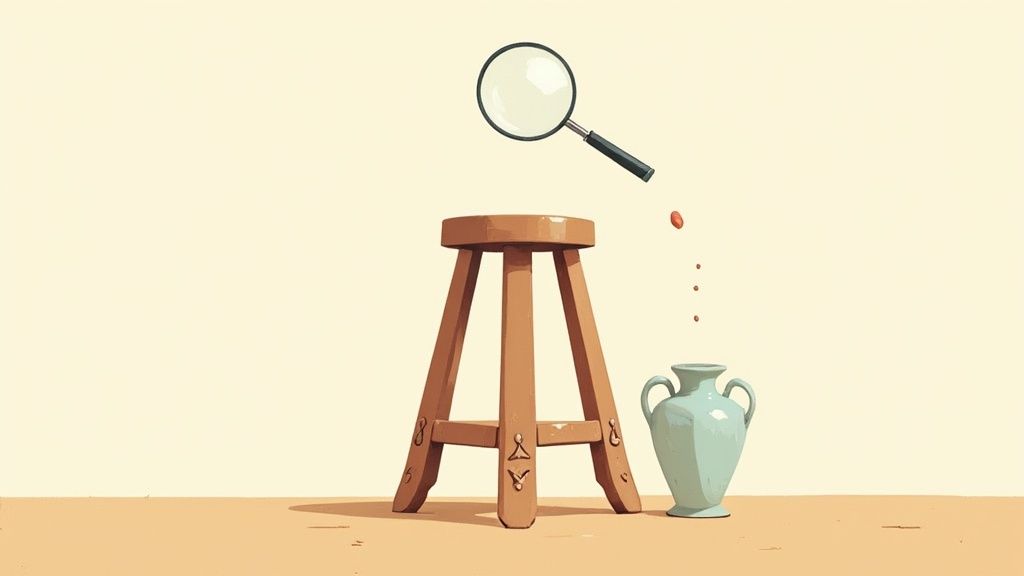Figuring out what an antique is actually worth can feel like a bit of a guessing game, but there's a real method to the madness. Think of any antique's value as a three-legged stool, with each leg representing a core principle: Rarity, Condition, and Provenance. If any one of those legs is wobbly, the whole price can come tumbling down.
How to Start Valuing Your Antiques
Diving into the world of antique valuation is a journey of discovery. It’s about moving beyond a quick online price search and into a genuine understanding of what gives an object its true worth. By learning to look at an item through the lens of Rarity, Condition, and Provenance, you'll start to build the confidence to size up anything—from that dusty armchair in the attic to a porcelain doll you spotted at an estate sale. This framework is your key to decoding an object's hidden story.
This isn't just a niche hobby, either. It’s your entry point into a massive, thriving market. In 2023, the global collectibles market, which is full of antiques and other rare finds, was valued at a staggering $288.34 billion. And it's not slowing down; forecasts predict it could climb to nearly $490 billion by 2033. This shows just how much people value cultural history and tangible investments. If you're interested in the numbers, you can dig deeper into these trends with this detailed collectibles market report.
The Three Pillars of Value
So, let's break down these core ideas. Treat them as your go-to checklist for every single piece you evaluate. Each pillar helps you ask the right questions, and together, the answers will give you a full picture of an antique’s desirability on the market.
- Rarity: How many of these were ever made? Is it a one-of-a-kind piece, or did it roll off a factory assembly line?
- Condition: What shape is it in? Are we talking mint, untouched condition, or is it showing its age with wear, repairs, or damage?
- Provenance: What's its life story? Can you trace its ownership back to a famous person, a specific historical event, or the original maker's workshop?
Getting a firm grip on these three pillars is the single most important step in any valuation. It gives you a reliable system, so you don't overlook the small details that can make a huge difference in an item's final price. Without this foundation, you’re just guessing.
Now, let's pull it all together in a quick summary.
The Three Pillars of Antique Value at a Glance
This table is your cheat sheet. It lays out the foundational factors that drive an antique's value, giving you a quick reference to use as you begin your appraisal journey.
| Pillar | What It Means | Why It Matters for Pricing |
|---|---|---|
| Rarity | The scarcity or uniqueness of the item. | Fewer items in circulation almost always means higher demand and a higher price tag. |
| Condition | The physical state, including original finish and any damage. | Flaws and poor repairs drag the value down, while pristine, original condition can send it soaring. |
| Provenance | The documented history of ownership. | A solid paper trail connecting an item to a famous owner or event can add immense value. |
Once you start mastering this framework, you're doing more than just memorizing facts—you're developing an appraiser's eye. This is the skill that helps you spot the hidden gems and understand why some old things are priceless treasures while others are just… old.
What Really Determines an Antique's Value?
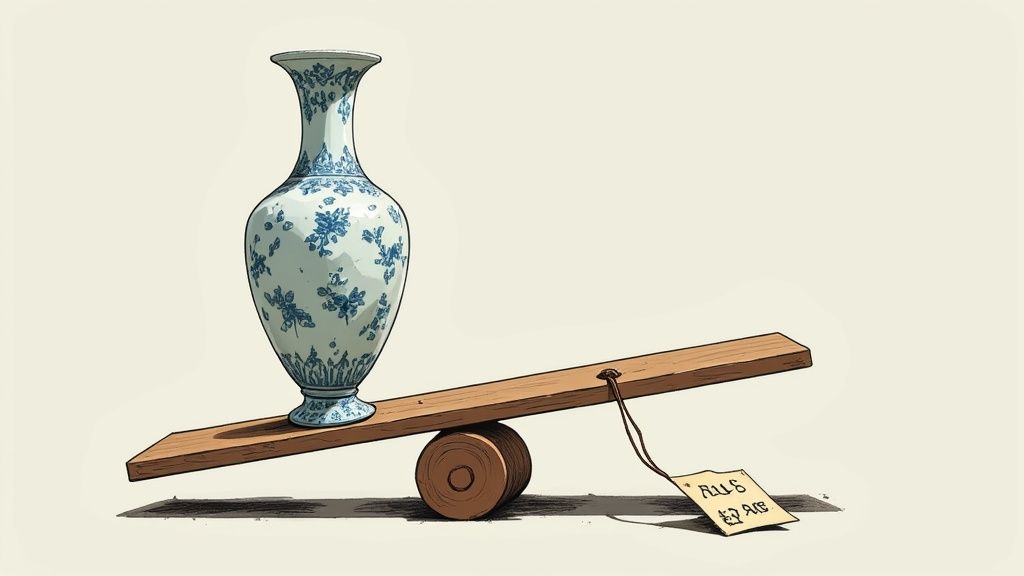
To accurately gauge what an antique is worth, you have to learn to see it through the eyes of a seasoned appraiser. It's about moving beyond a quick glance and digging into the specific characteristics that separate a genuine treasure from just another old thing. This isn't about one magic bullet; it's about methodically building a case for its value, one clue at a time.
Think of each factor as a value multiplier. It’s a bit like baking a cake. You start with the basics—flour, sugar, eggs—but it’s the rich chocolate, the pure vanilla, and the artful frosting that elevate it from a simple snack to a showstopper. Similarly, while an item's age is a starting point, the real value emerges from the interplay of its rarity, condition, and unique story.
Age and Rarity: The Foundation of Scarcity
Let's get one thing straight: age by itself doesn't guarantee value. For instance, countless glass bottles were mass-produced in the early 20th century. They're definitely old, but since they're not particularly rare, they aren't worth much. The real magic happens when age and rarity collide.
Imagine two 19th-century wooden chairs that look almost identical. One was from a massive production run, a common style you’d find in homes all over the country. The other was part of a limited commission from a celebrated craftsman, with only a dozen ever produced. Both are antiques, but the rare, well-documented chair is worth worlds more. Its scarcity is the key.
The question isn't just "How old is it?" but rather, "How many of these still exist?" When an item was common and many have survived, its value stays modest. When a desirable, well-made piece is hard to find, its price climbs.
Condition: The Story of Survival
An antique's condition is a physical testament to its journey through time, and it has an enormous impact on what someone will pay for it. Picture a sliding scale where every flaw, chip, or repair can either nudge the value down or send it plummeting. In this world, originality is king.
Here’s how condition typically plays out:
- Minor Wear: Small scratches or a soft patina that comes from years of gentle use can actually be a good thing. They help prove authenticity and add character, often without hurting the price.
- Significant Damage: A major crack in a piece of porcelain, a deep gouge in a table leg, or a torn canvas is a serious problem. Flaws like these can easily slash an item's value by 50% or more.
- Repairs and Restoration: A sloppy, obvious repair is often considered worse than the original damage. On the other hand, a masterful, nearly invisible restoration by a respected professional can help preserve some value, though it will almost never be worth as much as a piece in pristine, untouched condition.
Provenance: The Item's Pedigree
Provenance is simply the documented history of an object—its chain of ownership. This is the paper trail of receipts, old letters, photographs, and auction records that trace an item's life story. A strong provenance can add incredible value, transforming an otherwise ordinary object into a tangible piece of history.
Take a simple writing desk. On its own, it might be worth a few hundred dollars. But what if you have a photograph of a famous author sitting at that very desk, along with a letter confirming they owned it? Suddenly, its value could leap into the thousands. The desk is the same, but its story is not. That's the power of provenance.
Other Key Clues to Value
Beyond those big three, appraisers hunt for other crucial signals that build a complete value picture. Getting familiar with these will give you a much more accurate assessment. For a more detailed look, you can also check out our guide on how to find the value of antiques, which digs even deeper.
These other important factors include:
- Maker's Marks: Think of these as the signatures of the past. They are the stamps, labels, or engravings left by the creator. A piece clearly marked by a famous maker like Tiffany or Chippendale will always fetch a higher price than an identical, unmarked piece.
- Aesthetic Appeal: Let's face it, some designs are timeless, while others look dated. An object that is beautifully designed, well-proportioned, and captures a sought-after style (like Art Deco or Mid-Century Modern) will naturally have more buyers and, therefore, more value.
- Material Significance: What something is made of matters. A lot. An 18th-century cabinet crafted from imported mahogany is inherently more valuable than a similar one made from common pine. In the same way, solid sterling silver will always be worth far more than silver plate.
A Practical Guide to Researching Your Antiques
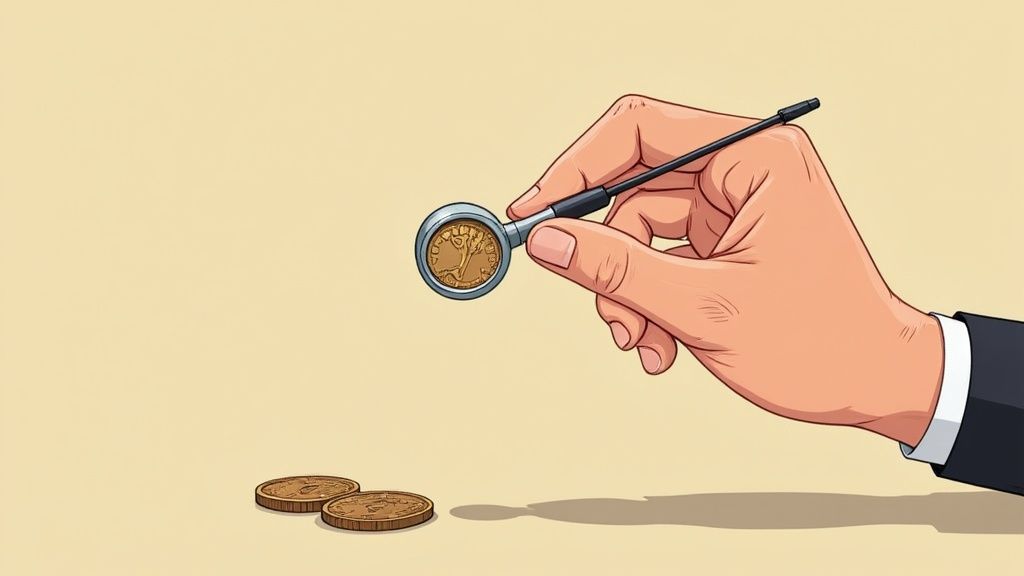
Now that you know what gives an antique value, it’s time to roll up your sleeves and become a detective. This is where the real fun begins—piecing together your item’s story to uncover its true worth. A methodical approach is everything here. It takes the guesswork out of the equation and lets you build a solid case for value based on facts, not just feelings.
The first stop on any good valuation journey is a hands-on inspection. Think of it as creating a case file for your piece. Your job is to document every single clue—the good, the bad, and the ugly—that will help you identify it later on.
Build Your Case File with an Initial Inspection
Before you even dream of typing a single word into a search bar, get up close and personal with your item. This initial examination is where you gather all the raw data that will fuel your research. A few clear photos taken at this stage will be your best friend.
Here’s what you need to capture:
- Maker’s Marks: Check the bottom, the back, or inside drawers for any signatures, stamps, or labels. These are often the single most important clue you'll find.
- Unique Characteristics: Make a note of anything that stands out. Is the design unusual? Are there hand-cut dovetail joints on a drawer? These details matter.
- Condition and Damage: Photograph every flaw. I’m talking about chips, cracks, stains, and even old, clumsy repairs. Being honest now saves a lot of headaches later.
- Overall Photos: Take clear, well-lit pictures from every single angle. This not only helps you remember the details but is absolutely essential if you decide to get an online appraisal.
With this visual evidence in hand, you’re ready to take your investigation online. You now have the specific details you need to navigate the vast world of databases and auction archives.
Tap into Online Databases and Price Guides
The internet has completely changed the game for antique research, giving us access to information that used to be locked away in specialized libraries. The market reflects this shift, with online art and antiques sales now a massive $10 billion industry globally. Price transparency is at an all-time high.
Think of online price guides as the stock market tickers for the antiques world. They show you what buyers have actually paid for similar items in the past, not just what sellers are asking today. That's a crucial distinction.
The most reliable price is a sold price. Asking prices can be based on hope, emotion, or a simple lack of knowledge. A history of verified sales provides a much more realistic benchmark for what your antique might be worth.
A single search result isn’t enough, though. To arrive at a reliable estimate, you have to cross-reference your findings across several different sources. This is how you build a complete picture and a price range you can actually defend.
Cross-Reference for Accuracy
Comparing what you find across multiple platforms helps you spot trends, identify outliers, and develop a much more nuanced view of your item’s market value.
Here are the key places I always check:
- Subscription Databases: Tools like WorthPoint or Kovels are the gold standard. They gather millions of sales records from places like eBay and major auction houses, giving you a huge dataset to work with.
- Auction House Archives: Always check the websites of major auctioneers like Sotheby's, Christie's, or Heritage Auctions. Their "sold" or "realized prices" sections are treasure troves of information, especially for higher-end items.
- Specialized Books and Library Resources: Don't dismiss old-school resources! Collector's guides and reference books often contain incredibly deep knowledge on niche categories, from pottery marks to furniture styles.
For a deeper dive into valuation techniques, our complete guide on how to value antiques walks through even more strategies and tools to help you get it right.
Navigating Different Antique Markets and Values
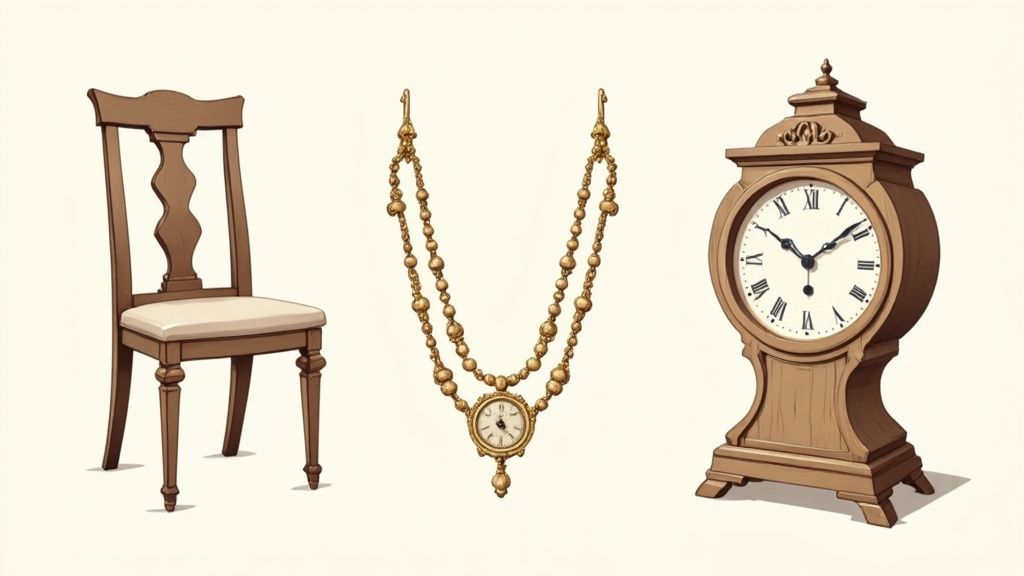
Here’s something every seasoned collector learns, sometimes the hard way: an antique almost never has one single, fixed price. Its value is surprisingly fluid, shifting dramatically depending on where you are and who you're selling it to. Getting your head around this is a crucial first step in any valuation journey.
Think about it like selling a car. You have the sticker price at the dealership, what you might get in a private sale, and the lowball trade-in offer. They're all different "values" for the exact same vehicle. Antiques are no different. The price tag depends entirely on the context, and knowing the difference is how you spot a fair deal—whether you’re buying, selling, or just insuring your collection.
The Three Core Types of Value
To really make sense of the market, you need to know about the three main types of value. Each one tells a different story and gives you a completely different number. Figuring out which one applies to your situation is key.
Retail Value: This is the big one. It's the price you see in a high-end antique shop or gallery. This number isn't just the item's worth; it's baked in with the dealer's overhead—their rent, staff, marketing, and years of expertise—plus their profit. It's the top-of-the-market price.
Fair Market Value (FMV): This is closer to the real-world price between two people. It’s what a knowledgeable buyer is willing to pay a knowledgeable seller, with neither party being forced into the deal. You’ll often see this value reflected in auction results or private sales.
Insurance Value (or Replacement Value): This figure represents what it would cost to replace your item with a nearly identical one, purchased from a retail source, often on short notice. Because of that urgency and the need to find a perfect match, this is almost always the highest valuation you’ll see.
Understanding the gap between retail and fair market value is critical. A dealer might offer you $500 for a chest of drawers (its Fair Market Value) and then turn around and put a $1,500 price tag on it in their shop (its Retail Value). Both figures are legitimate; they just represent two very different points in the life of that object.
How Geography Influences Price
Just as the type of sale matters, so does its location. An antique's worth can swing wildly based on local tastes, history, and demand. For instance, a piece of early American folk art will fetch a much higher price at a New England auction than it would at a sale in London. The local crowd gets it, they value its history, and that connection drives up the bids.
You can see this playing out on a global scale, too. Europe and Asia are two powerhouse markets, each with its own rhythm. Europe's market is built on a long-standing tradition of galleries and collectors, while Asia—particularly China—is experiencing a massive surge in demand as people reconnect with their cultural heritage. That means a Ming dynasty vase might cause a frenzy at a Hong Kong auction but get a lukewarm reception in Chicago. You can explore more about these global trends in this collectibles market overview on ResearchAndMarkets.com.
Once you grasp these market dynamics, you can start being strategic. If you're selling, you can find the market where your item will be most celebrated. If you're buying, you might find incredible bargains by looking in places where an item is overlooked. That's the kind of thinking that separates a casual hobbyist from a truly savvy collector.
Common Antique Valuation Mistakes to Avoid
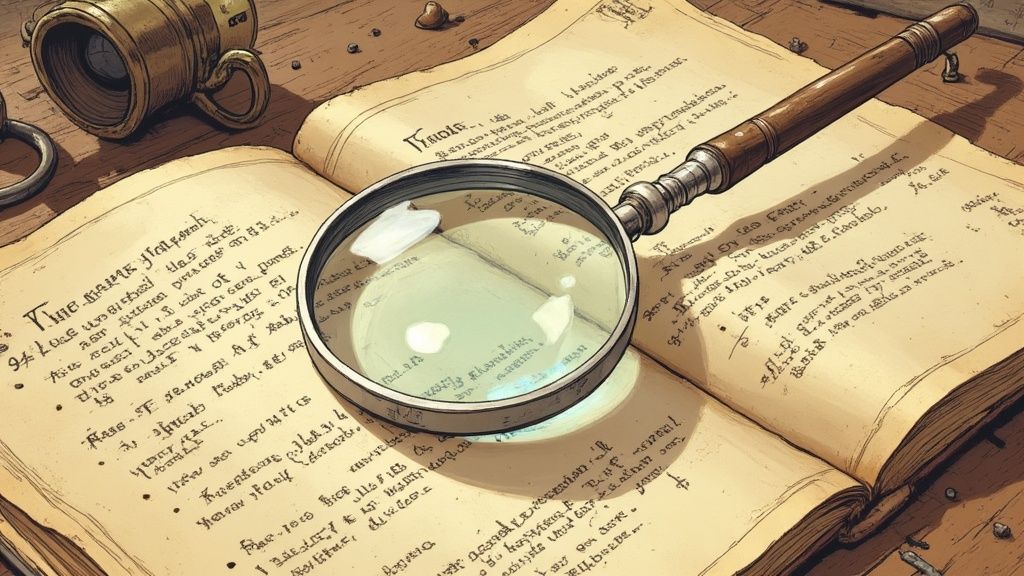
When you're trying to figure out what an antique is worth, it takes a sharp eye and a clear head. Even people who have been collecting for years can make missteps, either overpaying for something or, worse, letting a true treasure go for a song. This part of our guide is your "what-not-to-do" list, designed to help you sidestep the most common and costly blunders.
Think of this as learning from others' cautionary tales. Every mistake is a lesson that helps you build the confidence to value your items more accurately. By understanding these pitfalls, you'll be in a much better position to make smart decisions.
Confusing Sentimental Value with Market Value
This is probably the biggest and most understandable mistake of all. Of course, that rocking chair your great-grandmother used is priceless to you—it’s full of memories and family history. But the antiques market doesn't run on memories; it runs on supply and demand.
A beloved family heirloom might just be a common, mass-produced piece with little appeal to today's buyers. For instance, a simple oak press-back chair from the 1910s, while a cornerstone of your family's story, might only fetch $50 to $75 on the open market. You have to learn to separate your personal connection from an objective assessment of what it’s actually worth to someone else.
Market value is simply what a willing buyer will pay a willing seller. It has absolutely nothing to do with the personal stories or emotional meaning an item holds for its owner. Getting this distinction straight is the first real step toward an accurate valuation.
Misinterpreting Condition and Patina
Learning to tell the difference between desirable signs of age and deal-breaking damage is a skill that takes time to hone. A beautiful, warm patina on a bronze statue or the original, crackled finish on an 18th-century chest of drawers? That's the good stuff—the kind of authentic wear that can significantly boost an item's value.
On the other hand, a hairline crack in a porcelain vase, a deep chip on a crystal glass, or a clumsy repair on a piece of furniture can absolutely kill its value. These aren't charming quirks; they are flaws that will make a serious collector walk away. You have to learn to see the difference.
Believing Everything You See on TV
Antiques shows are fantastic entertainment, but they are not a reliable way to price your items. The exciting appraisals you see on screen are often "insurance values" or top-end retail prices, figures chosen specifically to create a jaw-dropping moment for the cameras.
That thrilling on-air valuation of $10,000 for a painting might realistically translate to $3,000 - $5,000 at a real-world auction. These shows rarely factor in seller's commissions, buyer's premiums, and all the other costs that come into play. Use them for inspiration and a bit of fun, but never for setting your prices.
Other Common Errors to Watch For
A few other frequent missteps can easily lead you astray:
- Misidentifying a Maker's Mark: Just finding a mark isn't the end of the story—it's the beginning. Many marks look alike, and forgeries are more common than you'd think. You have to do the research to confirm a mark is authentic and actually belongs to a valuable maker.
- Relying on a Single Source: Basing your entire valuation on one eBay listing or a single price guide entry is a recipe for disaster. Always cross-reference multiple sources—auction results, dealer websites, and specialized guides—to get a well-rounded picture of the market.
- Ignoring Regional Demand: Location matters. A piece of distinctive Texas pottery will naturally get more attention and a higher price in Dallas than it will in Boston. Forgetting to consider the local market can give you a completely skewed idea of an item's true value.
When You Should Call a Professional Appraiser
While this guide gives you some great tools to figure out what your antiques might be worth, there are times when a casual estimate just won't cut it. Knowing when to hand the reins over to a certified professional is a crucial part of managing your valuables wisely.
Think of it this way: doing your own research is perfect for satisfying your curiosity or slapping a price tag on a garage sale find. A professional appraisal, on the other hand, is a formal, legally recognized document. It’s the difference between a good guess and a valuation that will stand up in court or with an insurance company. When the stakes are high, you need the expert.
High-Stakes Scenarios
Certain moments in life absolutely require an official appraisal. In these situations, your own research, no matter how thorough, simply doesn't have the legal weight needed. You'll need a document from a certified expert.
These situations often include:
- Insurance Coverage: To properly insure a valuable piece, you need a formal appraisal to set its replacement value. Without it, you could be seriously underinsured if something gets damaged, lost, or stolen.
- Estate Settlement: When dividing up a family's assets, a certified appraisal ensures that every heir receives a fair share, which can go a long way in preventing family disagreements.
- Divorce Proceedings: Just like with estates, a formal appraisal is essential for valuing and dividing marital property accurately and equitably.
- Charitable Donations: If you’re donating an antique and want to claim a significant tax deduction, the IRS will require a “qualified appraisal” from a certified professional.
A certified appraisal isn't just an opinion; it's a formal declaration of value that provides legal and financial protection. For insurance, tax, or estate purposes, it is the only acceptable form of valuation.
Finding a Qualified Expert
Once you decide you need an official document, finding the right person for the job is everything. Not all appraisers are the same. You want to look for someone who holds credentials from a respected national organization. This ensures they follow a strict code of ethics and professional standards.
The top organizations to look for are:
- International Society of Appraisers (ISA): Members go through tough training and testing on appraisal theory, ethics, and deep knowledge of specific item categories.
- Appraisers Association of America (AAA): This group is a go-to for fine and decorative arts, and its members are recognized experts in their fields.
- American Society of Appraisers (ASA): A broad organization that certifies appraisers in many different areas, including personal property like antiques and collectibles.
When you reach out to an appraiser, they'll walk you through their process. This usually involves a hands-on inspection of the item, detailed market research, and writing up an extensive report.
Always ask about their fees upfront. To get a better handle on the investment, you can learn more about how much an antique appraisal costs in our detailed guide. Spending this money ensures your most important treasures are valued correctly and protected when it truly matters.
Frequently Asked Questions About Pricing Antiques
As you get more comfortable with valuing antiques, you’ll find the same questions tend to surface. Let’s tackle some of the most common ones I hear from collectors, clearing up the confusion so you can build on what you’ve already learned.
Is It a True Antique or Just Old?
This is the big one, the question that separates the serious from the curious. The generally accepted rule is that an item has to be at least 100 years old to earn the title of "antique." Anything younger than that, but older than 20 years, usually gets labeled "vintage."
So, how do you figure it out? You have to become a bit of a detective. Look for clues in the way something was made, the materials used, and its overall style. For instance, if you see hand-cut dovetail joints on a piece of furniture, you're likely looking at something made before machines took over. Machine-cut joints signal a later, more industrial era. The real trick is to combine these physical clues with any maker's marks you can find and compare them against historical design guides to really pin down the age.
Does Refinishing an Antique Decrease Its Value?
In almost every case, yes. A big, resounding yes. To a serious collector or a professional appraiser, the original finish—that beautiful, time-worn patina—is a huge part of the item's story and its authenticity. When you strip that away, you're essentially erasing its history.
A professional refinishing job, even one that makes the piece look brand new, can easily slash its market value by 50% or more. While a trained expert might perform minor conservation work that's acceptable, a full-blown refinish is a major red flag on a truly valuable piece.
What Is the Best Online Price Resource?
For trustworthy numbers, you can't beat subscription-based price guides like WorthPoint. The key difference is that they show you actual sold prices from years of auctions and sales, not just what someone is currently asking for an item online.
Think of it this way: asking prices can be pure fantasy. Sold prices are reality. It’s like the difference between a car's sticker price on the window and the final amount the buyer actually paid. One is a starting point; the other is what the market truly decided it was worth.
Is an Appraisal the Same as a Valuation?
People often use these terms interchangeably in casual chats, but in the professional world, they mean very different things.
- Valuation: This is essentially your educated guess of what something is worth. It's what you do when you research a piece for your own knowledge or to stick a price tag on it at a flea market.
- Appraisal: This is the real deal—a formal, legally recognized document of value that’s prepared by a certified professional. You need an appraisal for official business, like getting an item insured, settling an estate, or donating something valuable for a tax deduction.
Ready to turn that curiosity into real expertise? With Curio, you can instantly identify and value antiques using just a photo. Stop guessing and start uncovering the hidden stories and value in the objects around you. Download Curio and become a more confident collector today.
